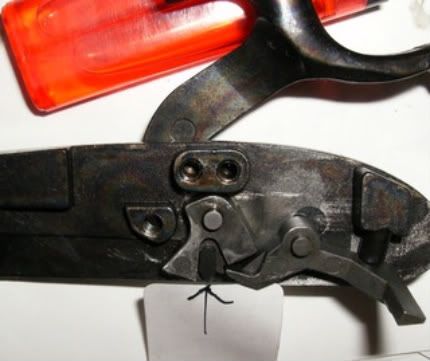The first thing to try is a good thorough cleaning of the lock to get rid of any crud that may be preventing the hammer from moving freely. an excellent product for lock cleaning is either automobile carburetor cleaner in a spray can or automobile brake cleaner in a spray can. Both are excellent cleaners but be sure to spray your lock outdoors and away from your wife's flowers. The stuff is not only tough on dirt, it is tough on plants as well. I spray mine in the driveway. It is also an excellent paint and varnish remover so don't get it on your stock. Remove the lock, take it to your driveway and thoroughly flush out all of the built up crud from your lock. If you have compressed air, blow it out until it is dry. If you don't have compressed air, not a problem, just let it lay and dry. The stuff evaporates quickly. It not only removes all of the crud, but it also removes all of the oil from your lock. So, lightly oil your lock and see how it works. If the problem was crud in your lock, problem solved! You will also want to check the bridle screws to be sure that they are just lightly snug and that your fly is moving freely in the tumbler. If nothing is rubbing or overly tightened, you should be good to go. With the lock clean and oiled and all screws properly tightened, one other thing to check is be sure that you have a #11 nipple and not a musket nipple. If somebody replaced the standard #11 nipple with a musket nipple, the #11 cap will not seat properly until it has been hit by the hammer and then will go off on the second try. If this is the case, just replace your nipple. Also if the nipple has been deformed from a misinformed previous owner who has dry fired the gun and allowed the hammer to strike the nipple with no cap on it enough times the end of the nipple will be deformed and prevent the cap from being properly seated. This, too, can cause the symptoms that you mentioned. This can be remedied by one of two things. The cheapest is to chuck the threaded end in an electric drill and turn it on slowly. then take a fine file and dress down the end of the nipple just until you have removed the flare caused by the nipple being struck by the hammer. This requires a bit of patience and careful filing while the nipple turns in the drill. The easiest method of repair is to simply replace the nipple if it is deformed.
Lastly, you can check to see if the hammer is striking the top of the nipple squarely by applying a bit of lipstick to a Q-tip and applying a light coating in the hammer face. Then gently lower the hammer onto the nipple and press it down hard with your fingers. Cock your gun so that you can get your finger in between the hammer and the nipple. Wrap a small piece of paper around your finger and press it carefully onto the nipple. If you get as nice complete circle, your hammer face is striking the nipple squarely. If you get a partial circle or even just a dot, it indicates that the hammer face is not striking the nipple squarely. Before making any changes, repeat this test several times making sure to apply an even coat of lipstick to the hammer face but not too much. Make sure that the paper around your finger does not touch the nipple until you press it down onto the nipple. You may even have to remove the hammer before pressing the paper onto the nipple to get it out of the way so you can get a good impression. If the hammer is not striking the nipple squarely, you may need to replace the hammer if the present one is damaged in any way. You may be able to take it to a qualified gunsmith and have the hammer bent until it strikes the nipple squarely. I have a gun where the hammer did not strike the nipple squarely when I got it and I was able to make the necessary adjustment to the hammer face with a Dremel tool and a small grinding stone. It is tedious work and required a lot of fitting using lip stick just I explained to you. Unless you have a Dremel tool and the delicate touch and patience to do the job correctly, I don't recommend attempting it. If you are a gunsmith, machinist, die maker, artist, dentist, etc. then you obviously have what it takes to do that kind of job. Go for it. Otherwise, leave it to the professionals.







